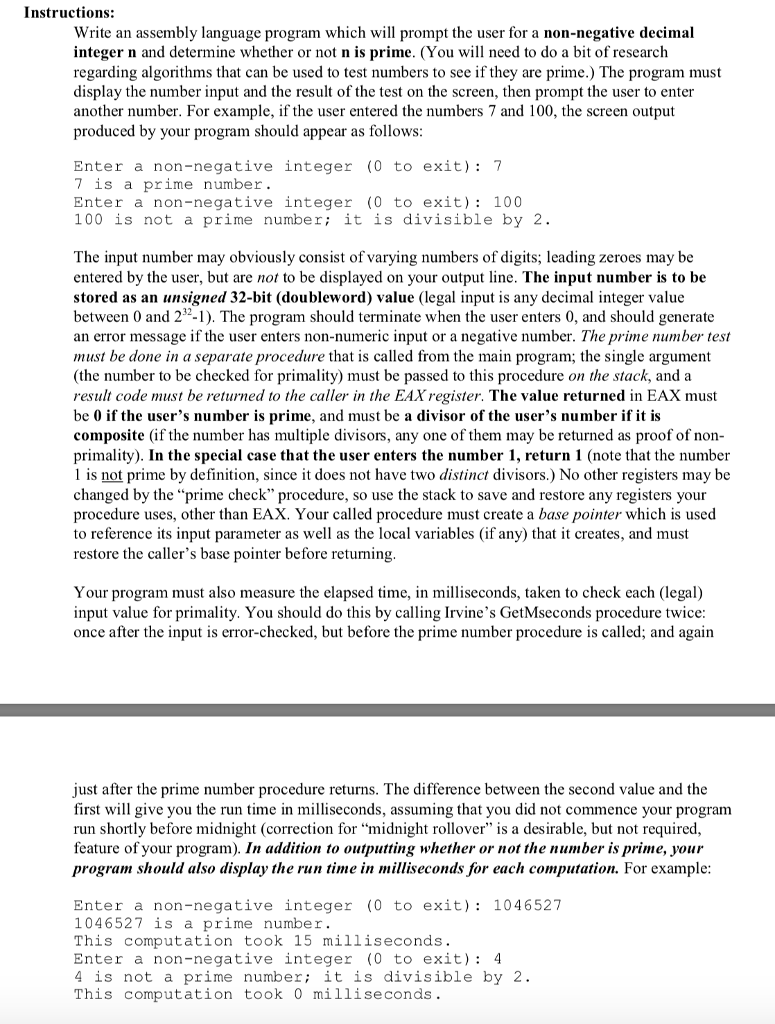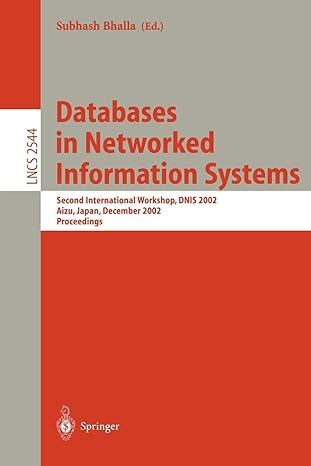Answered step by step
Verified Expert Solution
Question
1 Approved Answer
Provide the ASM code Instructions: Write an assembly language program which will prompt the user for a non-negative decimal integer n and determine whether or
Provide the ASM code

Instructions: Write an assembly language program which will prompt the user for a non-negative decimal integer n and determine whether or not n is prime. (You will need to do a bit of research regarding algorithms that can be used to test numbers to see if they are prime.) The program must display the number input and the result of the test on the screen, then prompt the user to enter another number. For example, if the user entered the numbers 7 and 100, the screen output produced by your program should appear as follows Enter a non-negative integer (0 to exit) 7 7 is a prime number Enter a non-negative integer (0 to exit): 100 100 is not a prime number; it is divisible by 2. The input number may obviously consist of varying numbers of digits; leading zeroes may be entered by the user, but are not to be displayed on your output line. The input number is to be stored as an unsigned 32-bit (doubleword) value (legal input is any decimal integer value between 0 and 232-1). The program should terminate when the user enters 0, and should generate an error message if the user enters non-numeric input or a negative number. The prime number test must be done in a separate procedure that is called from the main program; the single argument (the number to be checked for primality) must be passed to this procedure on the stack, and a result code must be returned to the caller in the EAXregister. The value returned in EAX must be 0 if the user's number is prime, and must be a divisor of the user's number if it is composite (if the number has multiple divisors, any one of them may be returned as proof of non primality). In the special case that the user enters the number 1, return 1 (note that the number 1 is not prime by definition, since it does not have two distinct divisors.) No other registers may be changed by the "prime check" procedure, so use the stack to save and restore any registers your procedure uses, other than EAX. Your called procedure must create a base pointer which is used to reference its input parameter as well as the local variables (if any) that it creates, and must restore the caller's base pointer before returning Your program must also measure the elapsed time, in milliseconds, taken to check each (legal) input value for primality. You should do this by calling Irvine's GetMseconds procedure twice once after the input is error-checked, but before the prime number procedure is called; and again just after the prime number procedure returns. The difference between the second value and the first will give you the run time in milliseconds, assuming that you did not commence your program run shortly before midnight (correction for "midnight rollover" is a desirable, but not required, feature of your program). In addition to outputting whether or not the number is prime, your program should also display the run time in milliseconds for each computation. For example Enter a non-negative integer (0 to exit): 1046527 1046527 is a prime number. This computation took 15 milliseconds. Enter a non-negative integer (0 to exit): 4 4 is not a prime number; it is divisible by 2. This computation took 0 milliseconds. Instructions: Write an assembly language program which will prompt the user for a non-negative decimal integer n and determine whether or not n is prime. (You will need to do a bit of research regarding algorithms that can be used to test numbers to see if they are prime.) The program must display the number input and the result of the test on the screen, then prompt the user to enter another number. For example, if the user entered the numbers 7 and 100, the screen output produced by your program should appear as follows Enter a non-negative integer (0 to exit) 7 7 is a prime number Enter a non-negative integer (0 to exit): 100 100 is not a prime number; it is divisible by 2. The input number may obviously consist of varying numbers of digits; leading zeroes may be entered by the user, but are not to be displayed on your output line. The input number is to be stored as an unsigned 32-bit (doubleword) value (legal input is any decimal integer value between 0 and 232-1). The program should terminate when the user enters 0, and should generate an error message if the user enters non-numeric input or a negative number. The prime number test must be done in a separate procedure that is called from the main program; the single argument (the number to be checked for primality) must be passed to this procedure on the stack, and a result code must be returned to the caller in the EAXregister. The value returned in EAX must be 0 if the user's number is prime, and must be a divisor of the user's number if it is composite (if the number has multiple divisors, any one of them may be returned as proof of non primality). In the special case that the user enters the number 1, return 1 (note that the number 1 is not prime by definition, since it does not have two distinct divisors.) No other registers may be changed by the "prime check" procedure, so use the stack to save and restore any registers your procedure uses, other than EAX. Your called procedure must create a base pointer which is used to reference its input parameter as well as the local variables (if any) that it creates, and must restore the caller's base pointer before returning Your program must also measure the elapsed time, in milliseconds, taken to check each (legal) input value for primality. You should do this by calling Irvine's GetMseconds procedure twice once after the input is error-checked, but before the prime number procedure is called; and again just after the prime number procedure returns. The difference between the second value and the first will give you the run time in milliseconds, assuming that you did not commence your program run shortly before midnight (correction for "midnight rollover" is a desirable, but not required, feature of your program). In addition to outputting whether or not the number is prime, your program should also display the run time in milliseconds for each computation. For example Enter a non-negative integer (0 to exit): 1046527 1046527 is a prime number. This computation took 15 milliseconds. Enter a non-negative integer (0 to exit): 4 4 is not a prime number; it is divisible by 2. This computation took 0 milliseconds
Step by Step Solution
There are 3 Steps involved in it
Step: 1

Get Instant Access to Expert-Tailored Solutions
See step-by-step solutions with expert insights and AI powered tools for academic success
Step: 2

Step: 3

Ace Your Homework with AI
Get the answers you need in no time with our AI-driven, step-by-step assistance
Get Started


